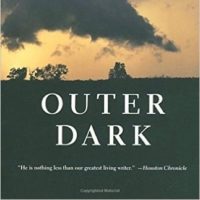I smoke tinderbox Chartwell aromatic tobacco in my Savinelli pipe; and when I read a Cormac McCarthy novel, it usually dangles from my mouth longer than it needs to be, and I refill it more than I should.
By the end of a reading session, I’m coughing and gagging like a character in his stories( lets call it “method reading”). Pipe tobacco is a nice compliment to a McCarthy novel: the aromatic presence smells of early Americana, the steam in the lungs verges on like an early locomotive , the wooden and sweet taste on the lips tastes like what I fantasize Appalachian dew would taste like, and the humidity in the mouth is like a camp fire shared with rogues. The pipe and tobacco are my wardrobe to his Narnia, and once your done with about 5 bowls of smoke, it becomes difficult to breathe, and only some of that difficulty can be attributed to the pipe. Outer Dark left me out of breath; a literary asthma attack propelled by a respiratory one.
Outer Dark is Cormac McCarthy’s second novel and should be accompanied by a glass of bourbon (for non-drinkers: a glass of water—no ice.) The book is set in timeless Appalachia, but we understand soon that time is nearing it’s end. If the reader chose, this book could be a prequel to The Road, as if the characters in both novels were edging on opposite sides of McCarthy’s apocalypse. In Outer Dark, a lonely sister gives birth to child she conceived with her brother . They live alone in the woods, so alone, that the lines of brother, sister and lover never seemed to have existed between these two. After the baby is born, the brother takes the baby deep into the woods and leaves it there, only to be picked up by a traveling tinker. What ensues is a pair of separate journeys , as the sister looks for her missing baby and the brother looks for work and his sister.
This story reads as a Southern fable; around each corner a new figure is met, or a new abode is entered, or an element of nature hardens the journey of our travelers. Life is gritty, violent, and unforgiving in Appalachia. McCarthy’s imagery juxtaposes the mythological with the real, creating a new modern tragedy that makes us believe we can tear down the sheets of its realist drama to expose a dark phantasmagoria lurking behind it. There is no chorus; they are dead, or have abandoned us.
Besides the brother and sister, whose names are Culla and Rinthy; all characters are depicted by their design:The man with the beard, The tinker and his “shoddy carilon”, The blind man, and The mute one. But the nameless ones know something that Culla and Rinthy do not, that their journeys are futile and that they have already reached their destination . As The man with the beard says at one point in the novel: they say people in hell ain’t got names. But they had to be called something to get sent there.
I look away from the book and stare at the bridge of my pipe. I appreciate how it reams and curves to the smoking dark pit of the bowl. I take a few puffs and see the smoke rise quickly in shouts, and there they are, little Culla and Rinthy walking to their end; I see them walking down the bridge of briar to the pit. Method Reading.




